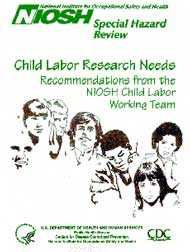Child Labor Research Needs
DHHS (NIOSH) Publication Number 97-143

Research Needs
When identifying occupational safety and health research needs for children and adolescents, the Child Labor Working Team considered existing knowledge, current research efforts, and needs expressed by stakeholders. These research needs are outlined in the following subsections.
Improved Surveillance for Work Related Injuries and Illnesses of Children and Adolescents
Substantial gaps exist in the coverage provided by occupational injury surveillance systems, and concerns exist about their underestimation of injuries in children and adolescents. Problems are greatest in the agricultural sector, but they occur across all industries. The occupational safety and health community needs to standardize nomenclature and establish a minimum data set to be collected on occupational injuries in children and adolescents. We need better understanding of the types of work children and adolescents do, the hazards they are exposed to, and the distribution of risk factors. The health outcomes of childhood work exposures have been hypothesized but not quantified. Information is needed to define the severity of disease and injury and the economic and social consequences. Consequently, we do not know the true impact of injuries and illnesses among children and adolescents. We need detailed information about the circumstances and contributing factors to inform intervention and research efforts. Surveillance at the State or local level can be an effective means for determining the focus for local intervention efforts.
Research to Identify Risk Factors for Work Injuries and Illnesses of Children and Adolescents
Children and adolescents appear to have a relatively high rate of occupational injury compared with adults. Numerous factors unique to children and adolescents may increase their risk for injury and illness. These factors include minimal work experience, lack of training in hazard recognition and safe work practices, and risk factors associated with physical and psychosocial development. To direct intervention efforts, we need to assess and quantify risk factors for injury and illness among working children and adolescents
Research to Assess the Age-Appropriateness of Work Tasks
At least two groups with substantial expertise in agricultural work injuries and illnesses have called for research to assess age-appropriate or developmentally appropriate work tasks: the National Committee for Childhood Agricultural Injury Prevention [1996] and the Agricultural Division of the National Safety Council [1996]. Guidelines for age appropriate tasks are needed for the nonagricultural sector as well. Ultimately, child labor regulations serve as lists of age appropriate and inappropriate work tasks. Decisions about appropriate work tasks for children and adolescents need to be guided by scientific data, theory, and principles in both regulatory and non regulatory environments.
Intervention Research
A broad range of intervention research is needed to address the engineering, administrative, and behavioral aspects of child labor hazards. These aspects must be addressed both separately (with targeted interventions that have narrowly defined outcome measures) and collectively (with interventions that have multiple outcome measures) [Goldenhar and Schulte 1994, 1996]. A solid research base is needed to focus interventions effectively. Implementation barriers and aides must be identified. Numerous interventions have been made to prevent work injuries to children and adolescents. Their effectiveness must be rigorously evaluated to identify the most efficient strategies and to assure that interventions do not have adverse consequences such as increased injury or illness rates from increased exposures.
Cost/Benefit Analyses of Models for the Healthful Employment of Children and Adolescents
Occupational safety and health professionals associate investments in injury and illness prevention with reduced costs as well as saved lives and limbs. However, data have not always been collected to document this association. Employers may be reluctant to invest in efforts with intangible benefits, especially if they perceive a low risk for injury and illness among their workers. A useful tool for safety and health programs would be model programs or best practices for healthful employment of working children and adolescents, with documented impacts on costs and productivity.
Research to Promote Occupational Safety and Health Education for Adolescents in School-Based or -Facilitated Work Experience Programs
Recent Federal initiatives such as School-to-Work heighten awareness about the occupational risks facing adolescents, and they provide opportunities for youths to be trained in occupational safety and health during their formative years. Recent NIOSH initiatives have assessed hazards and training needs in the vocational education environment. NIOSH hazard assessments in 11 vocational schools indicate the need for further evaluation. Not all of the schools were aware of the safety and health concerns associated with the industrial trades. The NIOSH assessments noted a lack of respirator programs and minimal hearing conservation programs. Many of the students were learning disabled. Hazard identification and intervention programs are needed to ensure safe educational environments for children and to provide critical knowledge about occupational safety and health.
Refinement and Expansion of Community-Level Interventions to Promote Safe and Healthful Work Experiences for Children and Adolescents
Every community sees the protection of its youth as a high priority. Children and adolescents, parents and other family members, school teachers and counselors, employers and community groups all have a stake in safe and healthful work experiences for children and adolescents. Targeted approaches to prevention hold tremendous potential for success and institutionalization of efforts. NIOSH demonstration projects will need to be tested in other communities to broaden our understanding and build on this knowledge.
- Page last reviewed: June 6, 2014
- Page last updated: June 6, 2014
- Content source:
- National Institute for Occupational Safety and Health Education and Information Division


 ShareCompartir
ShareCompartir